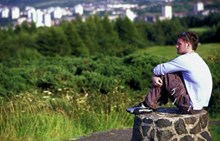18 August, 2014
Greenspace gives us the feel good factor
People who regularly visit their local greenspace are more likely to feel healthy, says a report published today (Monday 18th) by Scottish Natural Heritage (SNH).
The report’s findings show that regular visitors to their local greenspace are more likely to rate their health as good. Also, those rating their health as good are more likely to meet the national guideline for physical activity within an outdoor environment. However, the report finds that less than half of us visit our local greenspace or the wider outdoors once a week or more.
Greenspaces, such as parks, playing fields, allotments, woodlands and riverside walks, provide a range of economic, social and environmental functions that benefit both people and nature. The report highlights key findings from surveys conducted between 2004 and 2013 that relate to people’s Attitudes to greenspace in Scotland.
The survey results show that the majority of people in Scotland are aware of the benefits that these spaces can bring to their physical and mental well-being. However, a third of us do not do any outdoors physical activity.
The report shows that there is a widening gap between the expectations of what our urban greenspaces can be and what is actually provided in local communities.
John O’ Neil of SNH said:
“Maintaining and improving the quality of our local greenspaces in our towns and cities is vital to ensuring that they are used and valued by people. Despite the good practice that exists in Scotland in planning and managing urban greenspace, the surveys tell us that a third of people think that the quality of their local greenspace has declined over the last five years, with people living in the most deprived areas likely to be the most dissatisfied.
“Ensuring that people have access to good quality greenspaces close to where they live is important. It can help encourage people to visit regularly and be more physically active. This will mean people are more likely to be both healthier and also happier about their local neighbourhood; all of which in turn contributes to improving people’s health and well-being across Scotland.”
The report makes recommendations on how to best develop policy and support targeted action to improve the quality of Scotland’s urban greenspaces, and thereby contribute more to people’s quality of life. SNH commends the report findings and will promote them to those developing policies and making decisions that affect local greenspaces.
ENDS
The report published today highlights the key findings of surveys between 2004 and 2013 that relate to attitudes to greenspace of people living in urban areas. The report focuses on the 2013 findings of Scotland’s People and Nature Survey, supported and contextualised by results from other surveys. The report provides an analysis of the results of current and past surveys, including the first year of data collected by SNH’s Scotland’s People and Nature Survey (SPANS), and highlights policy messages. The report is available on the SNH website at http://www.snh.gov.uk/planning-and-development/advice-for-planners-and-developers/greenspace-and-outdoor-access/.
Scotland’s People and Nature Survey (SPANS) is a quantitative research survey which provides information on how people living in Scotland use, value and enjoy the natural environment. The survey was commissioned by Scottish Natural Heritage in 2013 with support from Forestry Commission Scotland, the national parks and Greenspace Scotland. It will provide information on the numbers of people in Scotland taking part in outdoor recreation, including the sorts of activities they enjoy and the types of places they visit; how engaged people feel with the natural environment; and the benefits they derive from visiting the outdoors. The full SPANS results will be published later this year at the end of September. http://www.snh.gov.uk/land-and-sea/managing-recreation-and-access/increasing-participation/measuring-participation/.
An extensive body of research shows how quality greenspace, which acts as an urban green infrastructure, provides a range of economic, social and environmental functions that can deliver benefits for people and nature. SNH factsheets that summarise the benefits can be found at http://www.snh.gov.uk/docs/A1366378.pdf
The Scottish Index of Multiple Deprivation (SIMD) produced by the Scottish Government ranks small areas from the most deprived to the least deprived. The surveys referred to in the report relate to the 10-15% most deprived areas. More details can be found at http://www.scotland.gov.uk/Topics/Statistics/SIMD.
Contact information
- Name
- Dominic Shann
- Job Title
- Media Relations Officer
- Telephone
- 01463 725157
- dominic.shann@nature.scot
NatureScot is Scotland's nature agency. We work to enhance our natural environment in Scotland and inspire everyone to care more about it. Our priority is a nature-rich future for Scotland and an effective response to the climate emergency. For more information, visit our website at www.nature.scot or follow us on X at https://x.com/NatureScot
’S e NatureScot buidheann nàdair na h-Alba. Bidh sinn a’ neartachadh àrainneachd na h-Alba agus a’ brosnachadh dhaoine gu barrachd suim a chur ann an nàdar. Tha e mar phrìomhachas againn gum bi nàdar na h-Alba beairteach agus gun dèilig sinn gu h-èifeachdach le èiginn na gnàth-shìde. Tha an tuilleadh fiosrachaidh aig www.nature.scot no air X aig https://x.com/NatureScot

